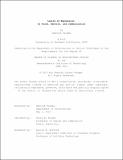Limits of Expression: On Touch, Emotion, and Communication
Author(s)
Tsogbe, Deborah
DownloadThesis PDF (4.284Mb)
Advisor
Knight, Terry W.
Terms of use
Metadata
Show full item recordAbstract
Touch, being the first sense to develop in the womb, is fundamental to human experience. The tactile sense allows us to investigate the world by providing a framework for understanding it through its relationship to our body. Tactile methods are capable of expressing concepts beyond language. The most effective and meaningful of these expressions are often emotionally charged. They often concern the unspeakable sentiment behind many of our social interactions, the interpretation of which lends a certain depth to our relationships, but beyond this, we often employ self-touch gestures unconsciously or consciously. Through these gestures, we communicate with ourselves – to self-soothe, as a nervous habit, a mindless fidget. Touch expressions can be deployed in countless ways, and we have only begun to understand them. In parallel, we have developed countless methods of expressing ourselves through digital means which subtract some sensory experience from communication. Perhaps the perpetual digital togetherness afforded by the networks we find ourselves living in has dulled our sensitivities to the physical realm of human experience and all that it embodies. As we continue to move further away from physical togetherness, we may lose an understanding of this emotional depth, or lose touch with ourselves. The intention of this research is to marry physical and digital means of communication to understand the unspoken ways in which we are attuned to our inner emotional states and the physical behaviors we use to then express and regulate those states. In this research, I craft a garment embedded with computational means, so that we might develop a methodology for observing how the body understands and expresses itself through touch, and in turn how it communicates with other bodies.
Date issued
2023-06Department
Massachusetts Institute of Technology. Department of ArchitecturePublisher
Massachusetts Institute of Technology